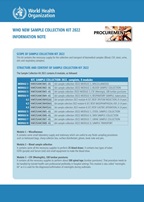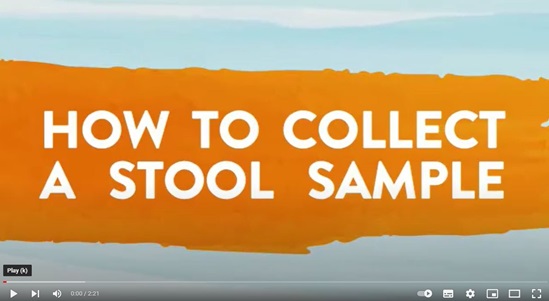Sample collection kit 2022 (SCK 2022)
This kit contains the necessary supply for the collection and transport of biomedical samples (Blood, CSF, stool, urine, skin and respiratory samples).
The main update in the new sample collection kit 2022 is on module 4, which previously was composed of only one module and is now dedicated to TB with 3 sub-sets corresponding to the different methods of TB sampling.
Please note that in June 2024, during the contract extension, some of the modules (highlighted in yellow) underwent updates based on feedback from the field.
Composition of the SCK 2022
The kit contains 8 modules as followed:
| KIT, SAMPLE COLLECTION 2022, complete, 8 modules. Rev. 8.2024 | ||
| MODULE 1 | KMEDSAMCKM1--A1 | (kit sample collection 2022 rev.1) MODULE 1, MISCELLANEOUS |
| MODULE 2 | KMEDSAMCKM2--A1 | (kit sample collection 2022 rev.1) MODULE 2, BLOOD SAMPLE COLLECTION |
| MODULE 3 | KMEDSAMCKM3--A1 | (kit sample collection 2022 rev.1) MODULE 3, CSF (Meningitis), 100 lumbar punctures |
| MODULE 4 | KMEDSAMCKM4--A1 | (kit sample collection 2022) MODULE 4, RESPIRATORY SAMPLE, tuberculosis |
| 4.1 | KMEDSAMCKM4SGA1 | (kit sample collection 2022 module 4) SET. RESP SPUTUM INDUCTION, 0-14 years |
| 4.2 | KMEDSAMCKM4SNA1 | (kit sample collection 2022 module 4) SET. RESP NASOPHARYNGEAL ASP., 0-14 years |
| 4.3 | KMEDSAMCKM4SSA1 | (kit sample collection 2022 module 4) SET. GASTRIC ASPIRATION, 0-14 years |
| MODULE 5 | KMEDSAMCKM5--A1 | (kit sample collection 2022) MODULE 5, STOOL SAMPLE COLLECTION |
| MODULE 6 | KMEDSAMCKM6--A1 | (kit sample collection 2022) MODULE 6, SKIN SAMPLE COLLECTION |
| MODULE 7 | KMEDSAMCKM7--A1 | (kit sample collection 2022) MODULE 7, URINE SAMPLE COLLECTION |
| MODULE 8 | KMEDSAMCKM8--A1 | (kit sample collection 2022) MODULE 8, SAMPLE TRANSPORT |

Module 1 MISCELLANEOUS
It includes small laboratory supplies and stationery useful for fluid sampling procedures, such as biohazard bags, a sharps collector box, surface disinfectant, gloves, a notebook, and a pen.
During the 2024 interim revision, the universal transport media (Viral transport media) was removed from the module as it compromised the overall shelf life. This item can now be requested separately from the WHO catalogue.
Module 2 BLOOD SAMPLE COLLECTION
It contains all the necessary supplies to perform 25 blood draws. Now split into two sets: one set containing only the vacutainers. During the interim revision, the EDTA (purple) and Serum (red) vacutainers were removed and listed as a separate set. This change was made to extend the shelf life of Module 2. However, please note that the new set 2 Blood Sample Collection Vacutainer has a very short shelf life.
Additionally, for blood collection, there is another kit available called the CTT kit 2021 - Collection, Testing & Transfusion Kit.
Module 3 CSF (Meningitis), 100 lumbar punctures
It contains all the necessary supplies to perform approximately 100 spinal taps (lumbar punctures). This procedure should be conducted by trained healthcare professionals, preferably in hospital settings. This module is also known as the "meningitis kit," as it is used for the diagnosis and confirmation of meningitis during outbreaks.
Module 4 RESPIRATORY SAMPLE, tuberculosis
It contains 3 different sets ( 4.1,4.2 and 4.3) corresponding to the different methods of
obtaining clinical samples from children for rapid molecular testing: expectoration, gastric aspiration, nasopharyngeal aspiration (NPA) and induced sputum. Note that those procedures are considered aerosol-generating procedures therefore should be performed in a well ventilated room, personnel should ware appropriate protection ( FPP2masks), glasses and gloves.
Procedures need to be handled by trained health care professional preferably in hospital settings.
Each sets contains small supply to perform about 20 procedures.
Note that the kit does NOT contain equipment such as suction pump, oxygen concentrator, nebulizer and respective spare parts. Devices and spare parts will need to be ordered separately on the WHO catalogue.
4.1 SET, RESP. SPUTUM INDUCTION, 0-14 years
Sputum induction can be done in people of any age who are unable to produce sputum spontaneously.
This method should be handled by specialised professional with adequate equipment and should not be done if the child suffer from respiratory distress (SO2 less than 92%). Note that this procedures is considered of high risk to generate aerosol and therefore health personal should be appropriately equipment and the room well ventilated.
For more information, please refer to WHO operational handbook on tuberculosis ( 2022) Annex 4. Standard operating procedures for sample collection methods Operational handbook annex 4. p220
4.2 SET, RESP. NASOPHARYNGEAL ASP., 0-14 years
Nasopharyngeal aspirate is a method that is suitable to peripheral health care setting than can be performed in outpatient setting. Follow the procedure as described in WHO operational handbook on tuberculosis ( 2022) Annex 4. Standard operating procedures for sample collection methods Operational handbook annex 4 . p220
4.3 SET, RESP. GASTRIC ASPIRATION (NPA), 0-14 years
Gastric aspirates are used for collection of samples for diagnostic testing when sputum cannot be spontaneously expectorated. This procedure requires the child to fast for more than 4 hours before its performance. Appointments for the gastric aspiration should be scheduled early in the morning so that the child can undergo the procedure after overnight fasting.
For more information, please refer to WHO operational handbook on tuberculosis ( 2022) Annex 4. Standard operating procedures for sample collection methods Operational handbook annex 4 . p220
Module 5 STOOL SAMPLE COLLECTION
It contains supply to collect 30 stool samples (faeces container and specimen collection swabs).
For Polio, there is another kit called “ KIT, POLIO SPECIMEN COLLECTION”
Module 6 SKIN SAMPLE COLLECTION
It contains supply to collect 20 skin samples including skin biopsy punch and scalpels disposable, Paraformaldehyde 8% and wound closure strips.
Module 7 URINE SAMPLE COLLECTION
It contains only 30 urine containers 100ml disposable, sterile, for urine sample collection.
Module 8 SAMPLE TRANSPORT
It contains various boxes and carriers designed for the transport and shipping of samples, including infectious substance packaging UN2814 and UN2900 (Category A), biohazard bags (red and yellow), a 2.6-liter vaccine carrier, and a cold chain insulated box measuring 35x35x35 cm.
Watch a video
Avtivities
Related publications
WHO operational handbook on tuberculosis: module 5: management of tuberculosis in children and adolescents
The WHO operational handbook on tuberculosis. Module 5: Management of tuberculosis in children and adolescents is the practical implementation...
Guidance for laboratories shipping specimens to WHO reference laboratories that provide confirmatory...
To expedite the shipment of clinical samples from patients with suspected COVID-19 virus infection from the country of collection to one of the WHO reference...
Related fact sheets
Related links

